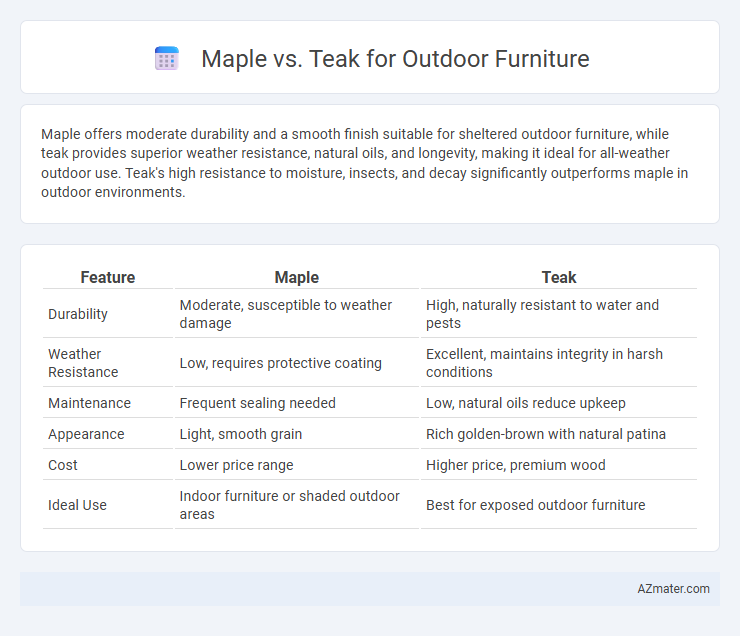Maple offers moderate durability and a smooth finish suitable for sheltered outdoor furniture, while teak provides superior weather resistance, natural oils, and longevity, making it ideal for all-weather outdoor use. Teak's high resistance to moisture, insects, and decay significantly outperforms maple in outdoor environments.
Table of Comparison
| Feature | Maple | Teak |
|---|---|---|
| Durability | Moderate, susceptible to weather damage | High, naturally resistant to water and pests |
| Weather Resistance | Low, requires protective coating | Excellent, maintains integrity in harsh conditions |
| Maintenance | Frequent sealing needed | Low, natural oils reduce upkeep |
| Appearance | Light, smooth grain | Rich golden-brown with natural patina |
| Cost | Lower price range | Higher price, premium wood |
| Ideal Use | Indoor furniture or shaded outdoor areas | Best for exposed outdoor furniture |
Introduction: Maple vs Teak for Outdoor Furniture
Maple and teak are popular hardwood choices for outdoor furniture, each offering distinct characteristics suited to different environments. Maple is known for its fine grain and durability but requires proper sealing to withstand moisture and weather exposure. Teak is naturally oily, highly resistant to rot and insects, and ages beautifully, making it a preferred option for long-lasting outdoor furniture.
Durability and Weather Resistance
Maple offers moderate durability and can withstand light outdoor exposure but is prone to warping and cracking under prolonged moisture and sunlight. Teak is highly durable and renowned for its superior weather resistance due to natural oils that repel water, resist rot, and prevent insect damage. Its dense grain and high oil content make teak the preferred choice for long-lasting outdoor furniture in harsh weather conditions.
Appearance and Aesthetic Appeal
Maple outdoor furniture exhibits a smooth grain with a light, creamy color that brightens outdoor spaces and suits modern, minimalist designs. Teak, renowned for its rich golden-brown hue and natural oily texture, ages gracefully to a silvery patina, enhancing its elegant, timeless look ideal for classic or rustic settings. Choosing between maple and teak depends on the desired aesthetic impact, with maple offering sleek brightness and teak providing durable warmth and natural sophistication.
Maintenance Requirements
Maple outdoor furniture demands regular sealing and protection against moisture to prevent warping and cracking, requiring more frequent maintenance compared to teak. Teak naturally contains oils that resist water, insects, and decay, minimizing maintenance needs and often only requiring occasional cleaning and oiling to preserve its appearance. The superior durability and weather resistance of teak make it a preferable choice for low-maintenance outdoor furniture.
Cost and Value Comparison
Maple outdoor furniture generally costs less than teak, offering a budget-friendly option with good durability but requiring more maintenance to prevent weathering. Teak commands a higher price due to its natural oils and dense grain, making it highly resistant to moisture, insects, and decay, which extends its lifespan significantly. The long-term value of teak often outweighs its initial investment, as it maintains structural integrity and aesthetic appeal with minimal upkeep compared to maple.
Sustainability and Environmental Impact
Maple outdoor furniture offers a sustainable choice due to its fast growth rate and widespread availability, reducing pressure on natural forests. Teak boasts exceptional durability and natural resistance to weather, lessening the need for chemical treatments, but its slow growth and high demand raise concerns about deforestation. Choosing responsibly sourced maple or FSC-certified teak ensures minimal environmental impact while providing long-lasting outdoor furniture options.
Comfort and Functionality
Maple offers a smooth, dense grain that provides a comfortable seating experience and resists dents, ideal for durable outdoor furniture. Teak's natural oils make it highly resistant to weather and insects, enhancing functionality by reducing maintenance needs and ensuring longevity. Both woods deliver excellent comfort and practicality, but teak's superior durability often makes it the preferred choice for long-term outdoor use.
Availability and Sourcing
Maple wood, primarily sourced from North America, is widely available and more affordable for outdoor furniture but requires proper treatment to withstand weather conditions. Teak, native to Southeast Asia, is highly sought after for outdoor use due to its natural oily content and durability, yet sustainably sourced teak is less abundant and typically commands a higher price. The availability of sustainably harvested teak depends on certifications like FSC, whereas maple's accessibility benefits from extensive forestry management and faster growth cycles.
Popular Uses in Outdoor Furniture Designs
Maple's dense grain and durability make it ideal for outdoor furniture pieces like benches, dining tables, and Adirondack chairs that require sturdy, weather-resistant construction. Teak's natural oils and high resistance to moisture and decay make it a top choice for premium patio sets, loungers, and garden benches exposed to harsh weather conditions. Both hardwoods offer aesthetic appeal and longevity, with maple favored for its fine texture and teak prized for its rich golden hue and exceptional resilience.
Final Verdict: Which Is Better for Your Outdoor Space?
Teak outperforms maple for outdoor furniture due to its exceptional natural resistance to moisture, decay, and insects, ensuring longevity and minimal maintenance in various weather conditions. Maple, while durable indoors, lacks the oil content and weatherproofing qualities that make teak ideal for outdoor environments. Choosing teak guarantees enhanced durability, aesthetic appeal, and value for prolonged use in your outdoor space.

Infographic: Maple vs Teak for Outdoor Furniture
 azmater.com
azmater.com